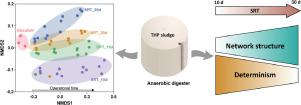Water Research ( IF 12.8 ) Pub Date : 2021-11-27 , DOI: 10.1016/j.watres.2021.117900 Liang Zhang 1 , Kun Guo 2 , Li Wang 1 , Ronghua Xu 3 , Dan Lu 1 , Yan Zhou 4

|
Thermal hydrolysis process (THP) assisted anaerobic digestion (AD) has been demonstrated to be an efficient approach to improve biogas production and solids reduction. Given the faster reaction kinetics in the THP-AD system, reduction of sludge retention time (SRT) is possible. However, a comprehensive understanding of the effects of sludge retention time (SRT) on microbial dynamics and community assemblages is still lacking in THP-AD systems. Thus, twelve THP-AD reactors were operated at different SRTs (10–30 d) to fulfill the knowledge gap. Results showed that, although all the bioreactors displayed good performance, shorter SRT reactors (SRT 10 d) took a longer time to reach the stable state. The total biogas production at SRT of 10 d was lower than that at other longer SRTs, attributing to the limited hydrolytic/fermentative capacities of AD microbiomes. Different SRTs resulted in distinct succession patterns of AD microbiomes. THP sludge reduced the microbial diversity in all the bioreactors over time, but longer SRTs maintained higher biodiversity. Null model analysis suggested that THP-AD microbial community assembly was predominately driven by deterministic selection at the tested SRT range, but stochasticity increased with elevated SRTs, likely attributing to the immigrants from the feedstock. Phylogenetic molecular ecological networks (pMENs) analysis revealed more stable network structures at longer SRTs, evidenced by the lower modularity, shorter harmonic geodesic distance, and higher connectivity. The potential keystone taxa under varied SRTs were identified, some of which were hydrolytic/fermentative bacteria (e.g., Peptostreptococcus, Lutispora, Synergistaceae), suggesting that these species related to organic hydrolysis/fermentation even with low-abundance could still play pivotal ecological roles in maintaining the THP-AD microbial community structure and functions. Collectively, this study provides comprehensive and in-depth insights into the mechanisms underlying community assembly in THP-AD reactors, which could aid in diagnosing system stability.
中文翻译:

污泥停留时间对热水解预处理污泥消化池中微生物演替和组装的影响:确定性过程与随机过程
热水解工艺 (THP) 辅助厌氧消化 (AD) 已被证明是提高沼气产量和减少固体含量的有效方法。鉴于 THP-AD 系统中更快的反应动力学,减少污泥停留时间 (SRT) 是可能的。然而,在 THP-AD 系统中仍然缺乏对污泥停留时间 (SRT) 对微生物动力学和群落组合的影响的全面了解。因此,十二个 THP-AD 反应器在不同的 SRT(10-30 天)运行以填补知识空白。结果表明,虽然所有生物反应器都表现出良好的性能,但较短的 SRT 反应器(SRT 10 d)需要更长的时间才能达到稳定状态。SRT 10 d 的总沼气产量低于其他较长的 SRT,归因于 AD 微生物组的有限水解/发酵能力。不同的 SRT 导致 AD 微生物组的不同演替模式。随着时间的推移,THP 污泥降低了所有生物反应器中的微生物多样性,但更长的 SRT 保持了更高的生物多样性。空模型分析表明,THP-AD 微生物群落组装主要由测试 SRT 范围内的确定性选择驱动,但随机性随 SRT 升高而增加,这可能归因于来自原料的迁移。系统发育分子生态网络 (pMEN) 分析揭示了在更长的 SRT 下更稳定的网络结构,这可以通过较低的模块性、较短的谐波测地距离和更高的连接性来证明。确定了不同 SRT 下的潜在关键分类群,消化链球菌、Lutispora、Synergistaceae),表明这些与有机水解/发酵相关的物种即使在低丰度下仍然可以在维持 THP-AD 微生物群落结构和功能方面发挥关键的生态作用。总的来说,这项研究提供了对 THP-AD 反应堆中群落组装的潜在机制的全面而深入的见解,这有助于诊断系统稳定性。


























 京公网安备 11010802027423号
京公网安备 11010802027423号